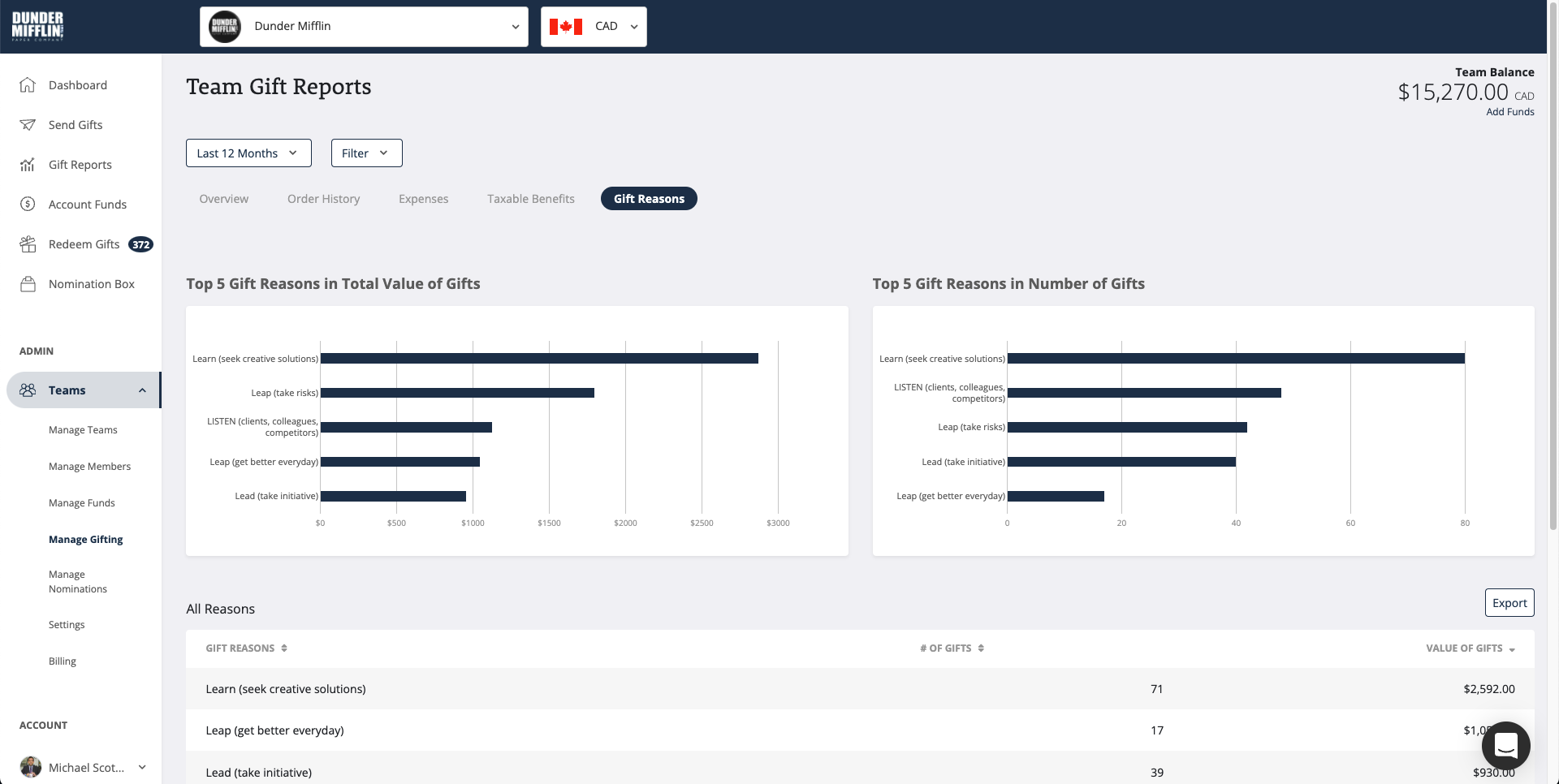How do you use employee recognition?
Different companies tend to recognize people for different reasons. Some will send recognition when employees reach specific goals, such as sales targets. Others send it en masse for special occasions like professional appreciation days.
And others might take a looser approach, simply sending spot recognition whenever an employee does anything that they feel is worth celebrating.
There’s absolutely nothing wrong with any of these approaches, and they can all help to boost morale and build a more positive, appreciative culture. But if this is all you do, you’re missing an opportunity to get much, much more from your program.
Recognition is at its most impactful when used by leaders strategically and deliberately to reinforce the behaviours they want to see from employees. One of the most effective ways to do this is tying employee recognition to core values.
Whether you already have a recognition program or are considering implementing one at your company, keep reading to learn why tying it to your core values could be the key to success, and how to do it.
Why tying employee recognition to core values is important
Your core values aren’t just nice words on your website or office wall. They’re supposed to be an integral part of your company’s identity – a summation of what you stand for, what your priorities are, and how you do business.
In many ways, they’re the cornerstone of your company’s culture, and should be treated as such by your people. They should serve as a touchpoint to guide the decisions they make, their working approaches, and how they treat others.
Unfortunately, this can be easier said than done. As much as you might communicate your core values to your team, it often won’t translate into meaningful differences in their working behaviour.
External pressures, differences in personalities and attitudes, and a general lack of understanding can all cause your core values to go by the wayside.
Making them a key part of your employee recognition strategy can help you change that. By simply recognizing employees when they do something that reflects your core values, you highlight their importance and reinforce them to your team.
This also serves to draw a clear line between your values and how they translate into your day-to-day work, making it easier for your employees to understand the ‘why’ of your values, and what they look like in action. And because they’re being rewarded for acting in line with your values, they’re more likely to keep doing it.
Over time, your values will actually become ingrained in your work culture, and demonstrating them will become almost second nature to your team.
And the best part? It works. A SHRM study found that 88 percent of organizations that tied employee recognition to core values said their programs helped instill and reinforce those values.
5 steps to tie your recognition program to your core values
Implementing this kind of strategic employee recognition program requires a bit of planning, but it isn’t too complicated.
For the most part, it comes down to simply taking a more deliberate approach to how you set up your program, train your employees to use it, and track your results. Here’s a 5-step breakdown of how to tie your program to your core values.
Step 1: Examine your core values
Before you start, it might be worth taking a second look at what your core values actually are. Do they truly reflect your culture and attitudes? Will they drive the actions you want to see? Will they actually provide helpful guidance to your people in the challenges they face?
It’s possible that they won’t. They might have been created a long time ago, and don’t reflect what your company has become as it’s evolved. Or they might have seemed fine as an abstract concept, but don’t really work as a real, practical touchpoint to help your employees do their jobs.
If you find that this is the case, it could be worth revamping them to better suit your organizational identity and the culture you want to create. Tying employee recognition to your core values won’t be effective if those values aren’t the right ones.
We went through this at Guusto. Our original core values didn’t really chime with who we were as an organization, so we scrapped them and started from scratch. We came up with new core values that were far more aligned with our culture:
- Listen: We seek to deeply understand customer problems and desires. We embrace feedback and respect diverse opinions.
- Learn: We practice radical curiosity. We constantly seek new wisdom, and further our learning by testing new ideas.
- Lead: We take initiative and own projects. We choose to focus on results, and are fully accountable for successes & failures.
- Leap: We push to get a little better everyday. We set ambitious goals and strive for high standards with everything we do.
If you need to do the same, check out this post on how to build core values that actually drive success to help you get started.
Step 2: Gauge your employees’ perceptions of your core values
You should also take some time to get a clear picture of your employees’ understanding of your core values.
Believe it or not, 19% of employees either don’t understand their company’s core values, or don’t even know what they are. Others might be skeptical about them, seeing them as meaningless words that have no real bearing on how the company operates.
Gauging the awareness, understanding, and attitudes your employees have about your core values will help you get a sense of how difficult it will be to place them at the centre of your recognition strategy.
Step 3: Set your core values as Gift Reasons in your recognition program
This is the most important part, but also the simplest.
Most recognition programs give you the option to add a list of preset ‘gift reasons’ that people can select when sending recognition. All you need to do is set up your program so that each of your core values is a gift reason option.
If needed, you can also include one or two other gift reasons for recognition that might fall outside of this, such as special occasions or milestones. Ideally, though, you should have as few as possible, so that most of the recognition your employees send will need to be tied to a core value.
Step 4: Coach your employees to recognize core values in action
Some of your people will immediately grasp the concept of tying employee recognition to core values, but others might need a bit more help. They might not see the direct connection between a value and the work their employees do, even if it exists.
If your culture is strong and your values are clear, though, it should be easy to draw a clear line between values and actions (if not, go back to step 1). It’s just a matter of coaching your employees to see it.
Giving them real-life examples of scenarios where your values come into play could be very helpful in this situation. As an illustration, here are a few examples of real recognition our employees sent at Guusto, and the core values they were linked to:
Listen - A member of our Customer Success team took feedback from customers to our Product Design team, sharing their insights to collaborate on improvements.
Learn - One of our QA Analysts shadowed a colleague during an interview process so that they could learn to do it themselves.
Lead - A member of our design team led a website revamp, owning the project from start to finish.
Leap - One of our Client Collaborators took on the challenge of leading the team while the head of their department was on vacation.
It might also be worth coaching them in how to write recognition messages in a way that highlights the core value the employee has demonstrated. This will help further reinforce your values in your recognition strategy.
Step 5: Measure Your Results
Tying employee recognition to core values doesn’t just help to reinforce those values – it also helps you measure them.
One of the great things about recognition programs is that they provide a number of useful data insights that can help you track not just when people are recognized, but why.
If you input your core values as gift reasons in Guusto, for instance, you can use the Gift Reasons report to see which of your values are being recognized most often by your team members.

This can tell you which ones are actually being put into action in the workplace, and which ones aren’t.
You can then use this information to help encourage both managers and employees to improve. For instance, if we found that a Guusto employee was not getting recognized often for demonstrating the ‘Lead’ value, their manager might encourage them to take more ownership of their work during reviews and one-on-ones.
Similarly, if we found that a manager wasn’t using ‘Leap’ as a gift reason, our leadership team might speak to them to find out why, and highlight the importance of encouraging employees to take risks.
Tracking which core values are most prevalent in your organization can also tell you where the company as a whole can improve. Let’s say we found that very few employees were being recognized for our ‘Learn’ value. That could be a sign that we need to invest more in learning and development resources, or just make more space for our team to try new things and upskill.
It’s like a 360 performance review that provides you with a tangible measure of how well your company is living its values on a day-to-day basis. It’s a simple but incredibly powerful tool to make your culture measurable.
Build your own strategic recognition program with our Playbook
Incorporating your core values is a key part of building an impactful, strategic employee recognition program, but what else is involved?
In the Ultimate Employee Recognition Playbook, we explore how to create effective recognition programs from start to finish. Using our six-step process, you’ll learn how to:
- Make the case for employee recognition
- Build your team of champions
- Find the right solution for your needs
- Set your goals
- Launch your program
- Measure the results
Click here to download your copy today:

















